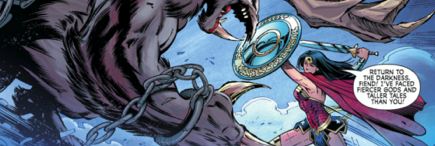Wonder Woman: Agent of Peace #16 // Review
The unknown can create fear. Fear can create monsters. Diana faces demons generated from fear in the forest on the edge of a village in DC Digital First’s Wonder Woman: Agent of Peace #16. The latest one-shot story in the series packs a profound amount of depth into 16 pages as writer Andrew Wheeler weaves a tale of inner power corrupted by a lack of understanding. Artist Paul Pelletier fuses inner conflict and supernatural horror with visuals that are as accomplished in action as they are in emotional drama. The thematic depth that Wheeler is attempting feels ever so slightly oversimplified in a single digital file. It’s not an easy task, but writer and artist manage a very emotionally engaging one-shot.
Wonder Woman is at a conference in Stockholm when she is contacted by the luminous supernatural spirit of a girl. The girl asks Wonder Woman to help with the darkness that has come to enshroud a small village. Massive wolves stalk the edges of a town that has been plunged into endless night. The source of that Yuri: a boy who wishes to be beautiful. Having been tormented by others has brought him in touch with dark powers that have summoned The Queen of Fables. Wonder Woman must confront demons brought into the world by someone who has lost faith in society.
Wheeler has very little space in which to explore the intricacies of harrowingly complex subjects like xenophobia, depression, and gender identity. It’s absurdly heavy stuff to delve into in the space of something slightly shorter than a normal comic book. Challenging themes hit the page with crude simplicity. What Wheeler is putting to the page is so painfully obvious. Wheeler constructs everything with such a powerfully sympathetic honesty. It doesn’t matter how simple it is. It’s still really, really emotionally powerful stuff.
Pelletier takes advantage of Diana’s natural connection to the world of the story. A few isolated moments aside, the visual impact of this story feels like it might be planted in a European sword-and-sorcery fantasy setting. Pelletier’s rendering of the animalistic supernatural is stylishly beastly. The garish harlequin villainy of the Queen of Fables plays against the far more sanguine and muted beauty of Yuri. Through it all, Diana’s sternly fearless heroism asserts itself with an earthbound confidence. Pelletier balances Wonder Woman’s fearlessness against some tenderness around the edges of the conflict.
As open as things are becoming, mainstream pop fiction still hasn’t found a whole lot of ground for exploration of matters like gender identity. An issue like Agents of Peace #16 remains a relative rarity to superhero fiction. It’s far from the first time this sort of thing has been featured on the comics page, but it’s still rare enough to be emotionally engaging. As envisioned by the first people to chronicle her exploits back in the early 1940s, Wonder Woman has always worked best when balancing action and aggression with empathy and understanding. She’s the perfect character to explore human conflict few other superheroes could.










